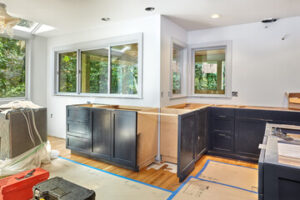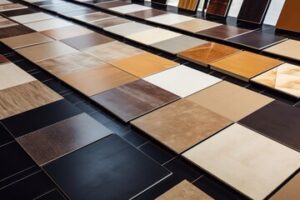Cabinet Refacing Sacramento is ideal for homeowners who want to give their kitchen a facelift without changing the layout. It also saves on dumping, landfill fees and ancillary costs like subcontractors, plumbers and electricians.

Standard particle board is made from leftover sawdust bound with resin. It’s not very durable and is prone to moisture and heat damage.
Cabinet refacing is ideal for homeowners looking to change the aesthetic of their kitchen without having to completely renovate. The beauty of this process is that it can be completed using materials that are as good, if not better than those used for new cabinetry. This gives you the freedom to choose a style that appeals to your personal tastes, while still giving you a finished product that can stand up to years of wear and tear in a busy kitchen.
The materials used in cabinet refacing are available in a wide variety of styles, finishes and colors, making it possible to achieve nearly any aesthetic you can imagine. For example, if you’re looking for a modern look, you can select cabinet doors with a sleek profile and add chrome hardware to create a contemporary appearance. On the other hand, if you prefer a more classic look, you can opt for raised-panel cabinet doors in a rich wood finish like cherry or oak. You can even choose a door color like gray or greige, which has seen a recent boost in popularity and works well with a wide range of design themes and hardware options.
Another benefit of cabinet refacing is that it allows you to keep your existing cabinet boxes and framing materials in place while upgrading the cabinet exteriors with a fresh new look. This can help you save money on a kitchen remodel, as well as reduce the environmental footprint of your project by keeping these components out of landfills.
By contrast, refinishing techniques like stripping and sanding can only improve the surface of your existing cabinets to a limited degree. Additionally, these processes require quarantining your kitchen and can introduce chemicals into your home’s living environment.
Another advantage of cabinet refacing is that it typically provides a better return on investment than other remodeling projects, such as a full kitchen renovation. This is because refacing involves a fraction of the labor and expense required for a complete remodel and can be completed in a shorter time frame. Refacing can also make your kitchen appear more modern and clean, which is likely to be a selling point for potential buyers.
Durability
Cabinet refacing allows homeowners to enjoy a new look without having to invest in a full kitchen renovation, which can be time-consuming and messy. Refacing is typically completed within a few days, allowing homeowners to get back into their kitchens and their lives sooner.
However, the durability of refaced cabinets depends on several factors, including the original material used and how they’re cared for. In general, refacing is more durable than painting or refinishing, but the longevity of refacing depends on the quality of materials and how well the job is executed.
The durability of refaced cabinets is also affected by how often they’re used and by environmental factors such as humidity. High humidity levels can cause wood to swell or warp, leading to problems with the lifespan of refacing materials. By maintaining proper ventilation in your kitchen and selecting materials that are well-suited to your climate, you can extend the lifespan of your refaced cabinets.
When you decide to reface your cabinets, it’s important to inspect the cabinet boxes for signs of water damage or mold. If you find any of these issues, you’ll need to replace the boxes before refacing them. This will significantly increase the cost of your project and may not provide the aesthetic you’re looking for.
It’s also a good idea to inspect the face frames of your cabinet box, as these can influence the durability of the final product. Ideally, you want to use solid-wood face frames that show no signs of damage or rot. Using damaged face frames can result in poor adhesion for your new veneers and prevent the doors from functioning properly.
While some cabinet companies offer wood refacing, most rely on thermofoil or laminate to give their cabinets the appearance of solid-wood cabinetry. These plastic sheets are not as durable as solid-wood, so they’re unlikely to hold up over the long term. However, some cabinet refacing companies use medium-density fiberboard covered in wood laminate to add more durability to their products. This material is better than thermofoil or laminate, but it’s still not as sturdy as solid-wood.
Efficiency
Cabinet refacing is a more eco-friendly alternative to replacing your cabinets because the original cabinet boxes stay intact, while new doors and fronts are installed on top. This helps to avoid unnecessary waste and minimizes the need for sourcing raw materials such as lumber that contains hazardous chemicals. Refacing also eliminates the need for new drawer boxes, which requires a significant amount of energy to manufacture and install. Furthermore, recycling old doors and drawer fronts cuts down on waste from wood and metal scraps that would otherwise be thrown away or sent to landfills, where they can leach hazardous substances into soil and groundwater.
In addition, cabinet refacing is less labor-intensive than complete replacements, as the process only requires the installation of new door and drawer fronts, along with new hardware. This significantly reduces the number of contractors required for the renovation and minimizes disruption to your kitchen. As a result, you’ll be able to enjoy your updated kitchen without having to endure weeks of construction inconvenience.
Before hiring a cabinet refacing company, take the time to research the contractor’s reputation and experience. Reading online reviews and seeking recommendations from friends and family can help you narrow down your choices and find the right fit for your project. Additionally, make sure that you’re working with a licensed, insured, and bonded professional.
The main requirement for refacing is that your cabinet boxes are structurally sound. You should inspect them for any signs of damage that could compromise their integrity, such as water stains or cracks in the joints. If your cabinets have any of these issues, you may need to replace them instead of refacing them.
Before the cabinet refacing team arrives at your home, prepare for the work by removing all items from the kitchen. This will help the contractors work more efficiently and prevent any misplaced items from getting damaged in the process. It’s also a good idea to clear a path from your kitchen to the rest of your home so that you can continue cooking and living normally during the renovation.
Budget
Cabinet refacing is a budget-friendly alternative to replacing cabinets and can save homeowners up to half the cost of a full kitchen renovation. However, it’s important to consider all of the factors that impact the final cost. The number of cabinets, type of materials, and geographic location will all affect the price. Additionally, adding custom features or choosing more expensive materials can increase the cost.
In addition, homeowners should be aware that refacing does not cover the interior of existing cabinets or any issues that may be present, such as water damage. Therefore, homeowners should be prepared to pay for any necessary repairs or replacements. Additionally, refacing does not include the installation of a new backsplash or countertops, which can add significantly to the overall project cost.
Regardless, it’s possible to save money on a cabinet refacing project by choosing lower-cost materials. For example, laminate is less expensive than solid wood, and it’s also easier to install yourself. Additionally, homeowners should shop around for quotes from several contractors before deciding on a company. Finally, it’s important to choose a contractor that is licensed and insured.
Ultimately, cabinet refacing is an excellent option for homeowners who want to update the look of their kitchen without breaking the bank. It’s especially beneficial for those who want to avoid major construction or don’t have the time to undertake a full kitchen renovation. However, it’s not a good choice for those who want to change their cabinet layout or functionality. It’s also not a good option for homeowners who need more storage space or have outdated, faulty cabinets.


